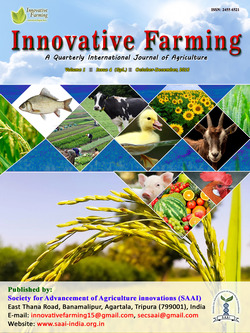
Performance of Promising Mustard (Brassica juncea L.) Cultivars under West Bengal Condition
A. Dutta*
Bidhan Chandra Krishi Viswavidyalaya, Mohanpur, Nadia, W.B. - 742101, INDIA
H. Banerjee
Bidhan Chandra Krishi Viswavidyalaya, Mohanpur, Nadia, W.B. - 742101, INDIA
R. Das
Bidhan Chandra Krishi Viswavidyalaya, Mohanpur, Nadia, W.B. - 742101, INDIA
DOI: NIL
Keywords: BARC, Mustard, Seed Yield
Abstract
Two high yielding mustard (Brassica juncea L.) cultivars TM-204 and TM-143 developed at Bhaba Atomic Research Centre (BARC), Trombay, Mumbai were used as initial material. The cultivars were tested in different agro climatic zones of West Bengal for 4 years at 16 locations. Among them TM-204, a yellow seed coat mustard produced seed yield of 1336 kg/ha and TM-143 another yellow seed coat mustard produced seed yield of 1316 kg/ha. TM-204 also demonstrated in farmers’ field trial and it surpassed the yield of local check varieties (B-85 and B-9) by 4.2 to 24.3 %. Both the entries were found superior for seed and oil yield over national (Kranti) and zonal check (Pusa Bold) varieties.
Downloads
not found
Reference
Dutta, A. 2016. Impact of Improved Technologies on Productivity and Profitability of Rapeseed-mustard Production at Farm Level in West Bengal, India. SAARC Journal Agriculture 14(2): 126-136.
Himani B. Patel, A.I. Patel, S.N. Saravaiya and Prayagbhai Golakiya. 2016. Modern cowpea breeding helps in adapting climate change. Innovative Farming, 1(4): 183-185.
Maluszynski, K. K., L. Nichterlein, Van Zanten and Ahloowalia. 2000. Officially released mutant varieties- the FAO/IAEA. Data base Mutant varieties. Breeding Reviews, 12: 1-84.
Vinoth, R. and R. Paramasivam. 2016. Innovation in agricultural research and education for agripreneurship development in India. Innovative Farming, 1(3): 72-78.
